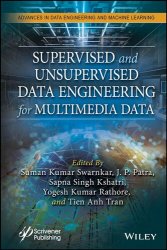Supervised and Unsupervised Data Engineering for Multimedia Data
- Добавил: literator
- Дата: 13-04-2024, 01:17
- Комментариев: 0
 Название: Supervised and Unsupervised Data Engineering for Multimedia Data
Название: Supervised and Unsupervised Data Engineering for Multimedia DataАвтор: Suman Kumar Swarnkar, J.P. Patra, Sapna Singh Kshatri
Издательство: Wiley-Scrivener
Год: 2024
Страниц: 372
Язык: английский
Формат: pdf, epub
Размер: 10.1 MB
Explore the cutting-edge realms of data engineering in multimedia with Supervised and Unsupervised Data Engineering for Multimedia Data, where expert contributors delve into innovative methodologies, offering invaluable insights to empower both novices and seasoned professionals in mastering the art of manipulating multimedia data with precision and efficiency.
Supervised and Unsupervised Data Engineering for Multimedia Data presents a groundbreaking exploration into the intricacies of handling multimedia data through the lenses of both supervised and unsupervised data engineering. Authored by a team of accomplished experts in the field, this comprehensive volume serves as a go-to resource for data scientists, computer scientists, and researchers seeking a profound understanding of cutting-edge methodologies.
The book seamlessly integrates theoretical foundations with practical applications, offering a cohesive framework for navigating the complexities of multimedia data. Readers will delve into a spectrum of topics, including Artificial Intelligence (AI), Machine Learning, and data analysis, all tailored to the challenges and opportunities presented by multimedia datasets. From foundational principles to advanced techniques, each chapter provides valuable insights, making this book an essential guide for academia and industry professionals alike. Whether you’re a seasoned practitioner or a newcomer to the field, Supervised and Unsupervised Data Engineering for Multimedia Data illuminates the path toward mastery in manipulating and extracting meaningful insights from multimedia data in the modern age.
Machine Learning (ML) approaches have been an important technique in various applications. To know a possible future illness by deploying particular health data has represented a vibrant area for these applications. This chapter investigates the important patterns of different ML classification techniques, and its ability and application in discovering future illness. In addition, this chapter aims to perform an effective ML classification method that can effectively tell the symptoms of illness of a person, based on the received symptoms from the model under development. Let us go through in detail how we can develop such a Machine Learning model.
Machine Learning algorithms deploy numerous mathematical techniques to train from previous available data and find out meaningful insights from enormous, unstructured and complex data sets. These ML techniques have various applications, covering text categorization, anomaly detection, e-mail filtration, credit card fraud prevention, detection of the customer purchase behavior, manufacturing optimization process and modelling for a particular illness. Many of these use cases have been performed using supervised learning of the ML techniques instead of unsupervised. In the supervised approach, a prediction model is constructed by training a data set where the class is already familiar and then the output of unlabeled illustrations can be said.
Here, we are interested in a Python-based implementation of various classification algorithms such as Naive Bayes, Random Forest, and Support Vector machine. All these algorithms will be trained by this pre-processed data, and further we test the quality of the developed Machine Learning model with the use of confusion matrix. We will study in detail about the confusion matrix. Till this point, we have trained all the three classification algorithms.
Скачать Supervised and Unsupervised Data Engineering for Multimedia Data
Внимание
Уважаемый посетитель, Вы зашли на сайт как незарегистрированный пользователь.
Мы рекомендуем Вам зарегистрироваться либо войти на сайт под своим именем.
Уважаемый посетитель, Вы зашли на сайт как незарегистрированный пользователь.
Мы рекомендуем Вам зарегистрироваться либо войти на сайт под своим именем.
Информация
Посетители, находящиеся в группе Гости, не могут оставлять комментарии к данной публикации.
Посетители, находящиеся в группе Гости, не могут оставлять комментарии к данной публикации.
